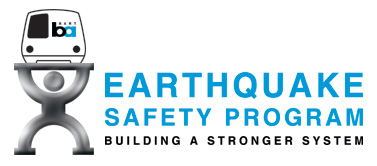
New! Sign up for email news and updates about BART's Earthquake Safety Program.
Special Note: Major Earthquake Safety Program Construction Work to Begin.
Click here for more information and construction updates.
Download the BART Earthquake Safety Program Presentation (1.3 mb)
Earthquake Safety Program
The San Francisco Bay Area Rapid Transit District (BART) has initiated the Earthquake Safety Program to upgrade vulnerable portions of the original BART system to ensure safety for the public and BART employees. Portions of the original system with the highest traffic will be upgraded not only for life safety but also to ensure that they can return to operation shortly after a major earthquake. The following are components of the overall Earthquake Safety Program:
Lake Merritt Administration Building Dismantling
The proposed project is the dismantling of the Lake Merritt Administration (LMA) building, which has been determined to be “at-risk” in the event of a large magnitude earthquake. It also includes reconfiguration of stairs, elevators, and certain building services. Following the dismantling and removal of LMA, the plaza would be restored to a safe and stable condition. Click here for more information on the LMA Dismantling Project.Citizens Oversight Committee
On November 2, 2004 Bay Area voters passed Measure AA, which authorized the BART district to issue bonds for $980 million dollars to make earthquake safety improvements to BART facilities in Contra Costa, San Francisco and Alameda counties. The measure also required BART to establish a Citizens’ Oversight Committee to verify that bond revenues are spent as promised. Click here for information on the Citizens’ Oversight Committee.
A Vital Transportation System
BART is one of the San Francisco Bay Area's most vital transportation links, averaging about 360,000 trips every day. During the peak of the commute across San Francisco Bay, BART carries as many trips as the San Francisco-Oakland Bay Bridge. The BART system represents a public investment currently valued at nearly $15 billion, with immeasurable importance to the local and regional economy.
Major Earthquakes Predicted
BART's success in maintaining continuous service directly after the Loma Prieta earthquake of 1989 reconfirmed the system's importance as transportation “lifeline”. However, Loma Prieta may not be the biggest test of BART’s ability to withstand seismic impact. A US Geological Survey statistical analysis predicts a high probability of one or more major earthquakes hitting the Bay Area within the next 30 years. Unlike Loma Prieta, which was centered more than 50 miles south of San Francisco, future earthquakes could be close to, or directly under the BART system.
|
|
Program Purpose and Benefits
Because of the likelihood BART will be subject to a major earthquake, and to safeguard the public's significant investment in the system, BART has initiated the Earthquake Safety Program. The program will upgrade vulnerable portions of the original BART system to ensure safety for the public and BART employees. Portions of the original system with the highest traffic will be upgraded not only for life safety but also to ensure that they can return to operation shortly after a major earthquake. The upgrades will be accomplished by using the latest seismic standards to improve structural integrity of BART facilities.
One of the first and most critical undertakings of the Earthquake Safety Program was a systemwide Vulnerability Study – an assessment of how system components would perform during a major earthquake. For more information on the Vulnerability Study and other technical information, click here.
System Elements
The Earthquake Safety Program addresses the original system completed between 1972 and 1976, with a service area spanning three counties (San Francisco, Alameda and Contra Costa). System extensions built mostly during the 1990's employed more stringent and up-to-date seismic criteria than the original system, and thus do not require upgrades. The original BART system includes the following elements:
-
74 miles of track
-
34 stations (11 aerial, 14 subway, and 9 at-grade)
-
The Transbay Tube
-
The Berkeley Hills Tunnel
-
Several train maintenance yards
-
Terminal, operations, and administration facilities
-
Power, mechanical, train control, and communications equipment
Duration and Funding
The estimated duration for design and construction of the entire program is approximately 10 years. The total project budget for the Earthquake Safety Program is $1,307 million (in 2004 dollars). The various funding sources are as follows:
-
$50 million from additional BART passenger revenues
-
$134 million from Caltrans Local Seismic Safety Retrofit Program
-
$143 from Regional Measure 2
-
$980 million from General Obligation Bonds (Measure AA was approved by voters in Alameda, Contra Costa and San Francisco counties on November 2, 2004.)
Last Updated: August 20, 2009
